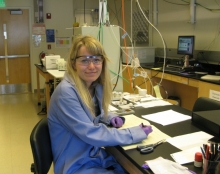
University:
Major:
Mentor(s):
Faculty Sponsor(s):
Faculty Sponsor's Department:
Project Title:
Project Description:
Palladium metal is widely used as a catalyst for many types of reactions, including coupling reactions and reactions for vehicular emissions. Based on resent research there is reason to believe that Pd-ions might be better catalysts than palladium metal for some types of reactions. The structure of some Pd-containing complex oxides may also facilitate conductivity. Through microwave-assisted solid-state reactions, we have prepared LiBiPd2O4, La2Pd2O5 and La4PdO7 in order to measure conductivity and probe Pd-ion stability. These materials have been prepared previously using conventional solid-state methods that require very long heating times and multiple re-grinding steps. We demonstrate that these materials can be prepared in a fraction of the time using the microwave-assisted solid-state method. Relatively high phase purity has been obtained and measured using X-ray diffraction and Rietveld analysis. The morphology and Pd-ion distribution was further examined through Scanning Electron Microscopy (SEM) and X-ray Photoelectron Spectroscopy (XPS) analysis. LiBiPd2O4 has a layered structure, which may give good electrical properties when doped with calcium. The results presented here will focus on structure-property relationship of PdO square planes connectivity in the oxide lattice, the resulting Pd ion stability, and any potential conductivity in LiBiPd2O4.
